Abstract
Dicliptera bupleuroides is a medicinal plant belonging to the family Acanthaceae and this is a perennial herb. Dicliptera bupleuroides also known as kaalu or kirch in local language. It is found in the planes of Pakistan and Afghanistan. Dicliptera bupleuroides possessed many kind of pharmacological properties like antioxidant, hepatoprotective, antimicrobial, antidiabetic and other biological activities. It contained phenols, flavonoids, ascorbic acid, lipids, starch, glycosides, and many other compounds. The purpose of this review article is to document the latest data about its medicinal use, traditional use, phytochemicals, and pharmacological activities and its toxicity of the plant.
Keywords
Dicliptera, Bupleuroides, Phytochemicals, Uses, Pharmacilogical, Toxicity, Medicinal.
Introduction
Medicinal plants or herbs are those plant which have medicinal value in them, these plants used since ancient times for their medicinal purpose and welfare of human beings. These plants mainly use to make Ayurveda medicine, as time passed different pharmaceutical industries also started to use these plants or herbs to manufacture herbal preparation. The preparation manufacture by these plants is based on established therapeutic efficacy explored from crude extract (1) (2). Now a day’s herbal preparation is widely used by different communities for their therapeutic value and have less or fewer side effect with cheap cost. On other hand medicine of synthetic origin has high cost and more side effect as they use different chemicals in them (3) (4). As the demand increase now a day’s almost 30% of the pharmaceutical preparations are based on plants, and most of the developed countries which have less herbs growth they import raw materials of important plants from developing countries (5). Dicliptera bupleuroides Nees. Of the family Acanthaceae is a perennial herb. It is found in the planes of Pakistan and Afghanistan. The common name in Urdu is kaali boti (6). Dicliptera bupleuroides possessed antioxidant, hepatoprotective, antimicrobial, and other biological activities. It contained phenols, flavonoids, ascorbic acid, lipids, starch, glycosides, and many other compounds (7) (8).
Scientific Classification (35)
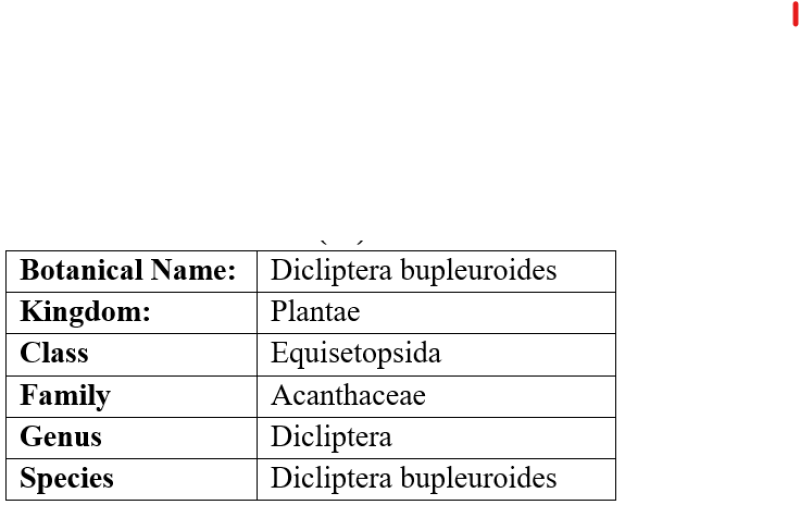
Plant Distribution
The plant Dicliptera bupleuroides is found in various reagions like Afghanistan, Assam, Bangladesh, Cambodia, China South-Central, East Himalaya, India, Laos, Myanmar, Nepal, Pakistan, Thailand, Vietnam, and West Himalaya. It is an annual or subshrub and grows primarily in the subtropical biome (36).
Botanical Description
This herb is about 90 cm long and leaves are elliptic, 2-15 x 1-8cm, shortly acuminate at both ends and dark green in color and flowers are mainly pink with purplish tinge, which is (1.2-1.5) cm long. Flowering: November-June 15. Corolla pink with white tube (rarely entirely white), 15-22mm, lobes longer than tube. Capsule clavate, pubescent, 7-8mm.
Traditional Use
Local people use this plant in various ways like the decoction of whole plant used as a tonic and they use the pastes of leaves for the treatment of eczema and the extract of leaves use as ear drops. This herb also cures snakebite wounds, stomach disorder, and bone fractures. It has antimicrobial, antioxidant and hepatoprotective activity along with gastroprotecive and insecticidal activities. The herb rich are flavonoids, phenolic compounds, lipids, glycosides and starch, etc (9).
Medicinal Uses
Dicliptera bupleuroides also cure the eye diseases and freshly crushed leaves when applied gently on the body three times in a day for a week in eczema. Fresh leaves of this plant can cure the diabetes and juice of this plant used to cure stomach problems which is used by local people of kadyala (10).
Phytochemicals
Determination of primary metabolites of plant dicliptera bupleuroides contains lots of active chemical constituents like
- Carbohydrates content
Carbohydrates are determined by performing the method followed by (11) but have certain modifications.
- Starch Content
Method followed to determine the starch content is of (12) where 100 mg powder sample was used to check the starch content in the plant.
- Protein Content
Plant also content proteins which is determine by the method given in (13).
- Amino acid content
Dicliptera bupleuroides contain amino acid which determine by using the method given in (14).
- Total Lipid Content
Following the Jadid method to determine the lipid content in the plant which shows the presence of lipid in Dicliptera bupleuroides (15).
Secondary Metabolites
- Glycoside
The presence of glycoside is determine using (16) Method.
After time Preliminary phytochemical analysis it revealed that Dicliptera bupleuroides contains different active chemical constituents like terpenoids, tannins, glycosides, flavonoids, alkaloids, proteins, carbohydrates, saponins, fats and fixed oils (17).
Pharmacological activities
Antibacterial Activity
The antibacterial activity of Dicliptera bupleuroides is performed with different fractions like n-exane, CHCl3, EtOAc and n-BuOH (18). Against two Gram-positive bacteria i.e. B. subtilis and S. aureus and also against two Gram-negative bacteria that is E. coli and P. multocida by using disc diffusion method using streptomycin sulphate.

Table 1: Zones of inhibition (mm) and MIC values of various fractions of Dicliptera bupleuroides against Gram-positive and Gram-negative bacteria
The inhibition growth zones was measured in mm and MIC was also calculated (19). Antibacterial activity of Dicliptera bupleuroides is performed by using four different bacteria two of them are gram positive and two of them are gram negative. For the growth of bacteria nutrient agar is form and culturing of bacteria’s were taking place on nutrient agar (20). The zone of inhibition is measure in mm and leaves and roots extract showed the activity against all tested bacteria. But the extract of stem not showed the effect against B. subtilis. On the other hand the highest zone of inhibition of leaves against B. subtilis with diameter (17.0±0.5) mm. Stem have the max. Inhibition zone against S. aureus with diameter (19.0±0.6) mm. And roots have (18.3±1.2) mm inhibition zone was obtained by S. aureus (21).
Antifungal Activity
Antifungal activity of D. bupleuroides is carried out with different fractions like n-exane, CHCl3, EtOAc and n-BuOH and checked against four different fungus like A. alternate, A. niger, G. lucidum, A. flavus.

Table 2: Zones of inhibition (mm) and MIC values of various fractions of, Dicliptera bupleuroides against Fungi
The growth inhibition zones of these fungus are measured in mm and also MIC was also calculated (19). To test the anti-fungal activity of D. bupleuroides two strains were used i.e. A. oryza, A. niger. For the growth of fungus PDA media is prepared for the culturing of fungus (22). To check its activity ethanolic extract of leaves, stem and roots were used and the extract of leaves showed the antifungal activity against A. oryza along inhibition zone formation about 12.3±0.9 mm but against A. niger its showed no effect. On other hand stem shows activity against both fungi and the inhibiton zone is 9.7±0.8 mm and 10±0.6 mm respectively. Whereas root extract of the plant have effect on A. niger and inhibition zone is (11.3±0.6) mm but no effect against A. oryza (21).
Hemolytic Activity
It’s important to check the haemolytic activity of the herbal plants which have antioxidant, antimicrobial and other bioactivities, so that we can use them for pharmacological bioactivities. Before any drug discovery it’s important to check its cytotoxic effect that’s why now a days it’s becoming new area of research in the drug lead discoveries(23). Different fractions of D. bupleuroides that is EtOAc, chloroform and n-butanol fraction found out that they have very less toxic effect only about 1-3 %, but in other hand the n-hexane fraction of D. bupleuroides showed 79% toxicity.
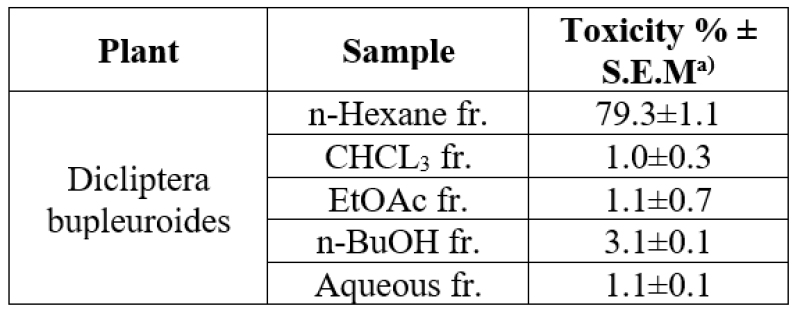
Table 3: Hemolytic activities of various fractions of Dicliptera bupleuroides.
The hemolytic activities of D. bupleuroides extracts were compared with the triton (19). The acute toxicity of the methanolic extract of the plant Dicliptera bupleuroides at the doses of 500, 1000, and 2000 mg/kg/p.o which showed 0 % toxicity in rats and and 100% mortality of animals (24). In vitro haemolytic activity is perform with fresh human blood where Triton-X was used as positive control and PBS served as negative control. Hemolysis % was calculated by using the formula: The extract of plant does not show or display any kind of toxic effect or mortality even in high doses. To check the DNA damage protection assay of Dicliptera bupleuroides where different fractions of plant extract is used to protect genomic DNA was determined using a method with slight modification (25) (26). In this the DNA damage was induced by hydroxyl radicals generated from Fenton’s reagent. The DNA protection assay showed the safe use of animal as well as human (27). Toxicity study of plant Dicliptera bupleuroides is performed on 12 male mice in 3 different group and given them the dose of 1g/kg, 2g/kg and 5g/kg of ethanolic extract of leaves, root, and bark and down procedure is followed according to (28). As the result there is no mortality in mice and the behaviour is observed is normal (21).
Anthelmintic Activity
To check the anthelmintic activity of the plant Dicliptera bupleuroides the experiment is performed on earthworm which is collected from crops field of Sialkot. The activity is carried out according to the method of Ajaiyeoba (29).
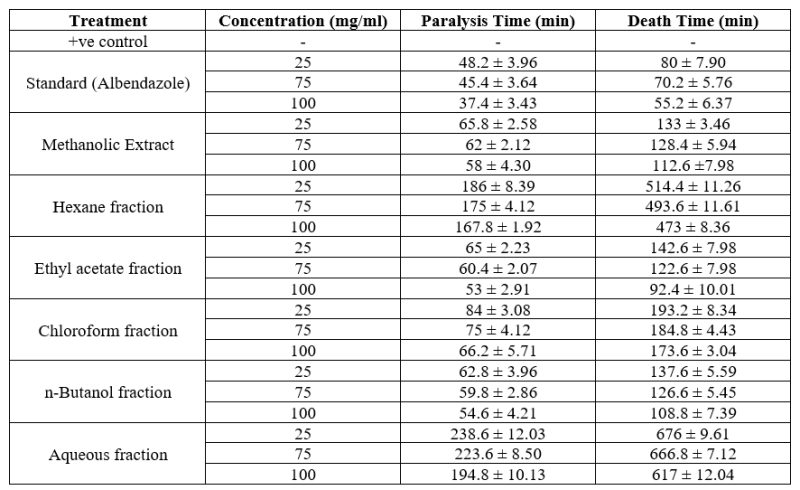
Table 4: Anthelminthic activity of Dicliptera bupleuroides Nees.
To check this properly different fractions of dicliptera bupleuroides i.e. methanol, hexane, ethyl acetate, chloroform, n-butanol, aqueous were use against adult Indian earthworm in three different concentrations i.e 25, 75, and 100mg/ml. Albendazole (20 mg/ml) is used as standard drug (24).
Insecticidal Activity
To check the insecticidal activity of the plant Dicliptera bupleuroides the experiment is performed on test insects which are Tribolium castaneum, Sitophilus oryzae, and Rhyzopertha dominica of same size and age of each species. Permethrin is use as standard insecticidal (30).
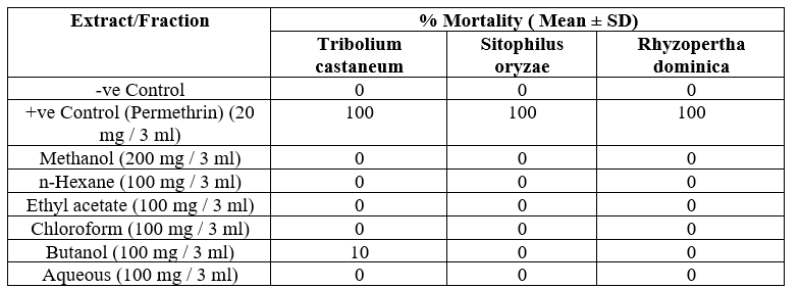
Table 5. Insecticidal activity of different fractions of Dicliptera bupleuroides Nees.
Different fraction of Plant Dicliptera bupleuroides hase no insecticidal effect on any of the tested samples which Tribolium castaneum, Sitophilus oryzae, and Rhyzopertha dominica (24).
Antiulcer Activity
To check the antiulcer activity Ethanol-induced Gastric Ulcer Model is used in wistar rats followed the method of Mizui (31). To measure the ulcer index in rats all stomach lesions were measured with the help of transparent millimetre scale and magnifying glass (32). Drugs like omeprazole, sucralfate, ranitidine used as reference drugs. Formula were used to calculate the inhibition percentage is:
% Gastro protection/Inhibition = (UIC – UIT)/UIC X 100 Where UIC is Ulcer Index in the control and UIT is ulcer index in the test rats (33).
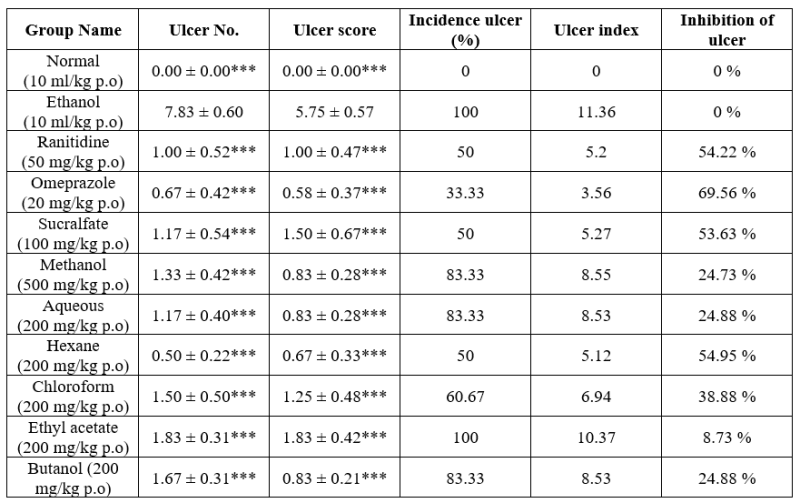
Table 6. Effect of different fractions of Dicliptera on the ethanol-induced gastric ulcer.
The n-hexane fraction showed the maximum %age inhibition of ulcer and after that chloroform also showed significant inhibition (24).
Hepatoprotective Activity
The hepatoprotective activity is carried out by using wistar rats using paracetamol-induced liver injury model according to the documented method (34).
Acute hepatoprotective study
The acute hepatoprotective study is performed in rats with different fraction of D. bupleuroides i.e. methanol, n-hexane, chloroform, ethyl acetate, aqueous, n-butanol. Silymarin is used as standard and paracetamol is use to induce the liver injury in rats.

Table 7: Acute Hepatotoxic effect on serum enzyme levels of different fractions of Dicliptera bupleuroides Nees.
Paracetamol is used for liver injury in rats which is responsible to raise the AST, TB, ALT, MDA and ALP and decrease GSH level. While n-hexane fraction of D. bupleuroides effectively restored all these changes (27).
Chronic hepatoprotective study
Chronic hepatoprotective study is perform with only one fraction of plant which is n-hexane for 14 days. The blood sample were collected to determine the enzyme serum level and liver were for histopathology.

Table 8: Effect of n-hexane fraction of Dicliptera bupleuroides Nees. Serum enzymes in paracetamol induced chronic hepatotoxicity (level of significance *** p>0.001,** p>0.01,* p>0.05)
Paracetamol is used for liver injury in rats which is responsible to raise the AST, TB, ALT, MDA and ALP and decrease GSH level. While n-hexane fraction of D. bupleuroides effectively restored all these changes (27).
Anti-diabetic activity
Anti-diabetic activity is performed on mice were diabetes is induced on male mice by single intraperitoneal injection of alloxan (120 mg/kg) prepared in normal saline. Metformin is use as standard and ethanolic extract of D. bupleuriodes leaves, stem and root was prepared and blood glucose levels were analysed using accucheck glucometer. As result the ethanolic extract of leaves at 250mg/kg dose decrease the blood glucose level significantly and it again start increasing but not reaches its first level. The dose 250mg/kg of leaves showed 243.6±3.4 at 0 h, and after 24h it decrease to 189.4±9.1. Stem in other hand show 213.6±4.8 at 0 hr and 218.6±9.4 at 24h it shown no significant. But ethanolic extract of roots show no significant result at 0 h was 205.4±2.1 and value after 24 h was 193.6±9.6 (21).
CONCLUSION
Dicliptera bupleuroides is a very important medicinal plant which have no harmful effect to human and it has various pharmacological properties like antioxidant, hepatoprotective, antimicrobial, antidiabetic and other biological activities. The plant have lots of active chemical constituents like phenols, flavonoids, ascorbic acid, lipids, starch, glycosides, and many other compounds. This plant needs to be explore more to find out more benefits and medicinal use of dicliptera bupleuroides.
REFERENCE
- Hassan LG, Mshelia HE, Umar KJ, Kangiwa SM, Ogbiko C, Yusuf AJ. Phytochemical Screening, Isolation and Characterization of Beta-Sitosterol from ethyl acetate Extract of Stem Bark of Entada africana (Fabaceae) Guill. et Perr. J Chem Soc Niger. 2018;43(3).
- Youssef FS, Hamoud R, Ashour ML, Singab AN, Wink M. Volatile oils from the aerial parts of Eremophila maculata and their antimicrobial activity. Chem Biodivers. 2014;11(5):831–41.
- Rashrash M, Schommer JC, Brown LM. Prevalence and predictors of herbal medicine use among adults in the United States. J patient Exp. 2017;4(3):108–13.
- Kumar M, Prakash S, Radha, Kumari N, Pundir A, Punia S, et al. Beneficial role of antioxidant secondary metabolites from medicinal plants in maintaining oral health. Antioxidants. 2021;10(7):1061.
- Nweze C, Ibrahim H, Ndukwe GI. Beta-sitosterol with antimicrobial property from the stem bark of pomegranate (Punica granatum Linn). J Appl Sci Environ Manag. 2019;23(6):1045–9.
- Ajaib M, Khan Z, Zikrea A. Ethnobotanical survey of some important herbaceous plants of District Kotli, Azad Jammu & Kashmir. Biol. 2014;60(1):11–22.
- Bahuguna RP, Jangwan JS, Kaiya T, Sakakibara J. Flavonoids and fatty acids of Dicliptera roxburghiana. Int J Crude Drug Res. 1987;25(3):177–8.
- Ahmad B, Khan MR, Shah NA, Khan RA. In vitro antioxidant potential of dicliptera roxburghiana. BMC Complement Altern Med. 2013;13(1):1–10.
- Pandey A, Tripathi S. Concept of standardization, extraction and pre phytochemical screening strategies for herbal drug. J Pharmacogn Phytochem. 2014;2(5):115–9.
- Pande PC, Tiwari L, Pande HC. Ethnoveterinary plants of Uttaranchal—A review. 2007;
- Chandran R, Nivedhini V, Parimelazhagan T. Nutritional composition and antioxidant properties of Cucumis dipsaceus ehrenb. ex spach leaf. Sci World J. 2013;2013.
- Rahul Chandran RC, Parimelazhagan Thangaraj PT, Saravanan Shanmugam SS, Sajeesh Thankarajan ST, Arunachalam Karuppusamy AK. Antioxidant and anti-inflammatory potential of Monochoria vaginalis (Burm. f.) C. Presl.: a wild edible plant. 2012;
- Shukla A, Vats S, Shukla RK, Painuly D, Porval A, Tyagi R. Phytochemical evaluation proximate analysis and biological activity of Reinwardtia indica dum leaves. Int J Pharmacogn Phytochem Res. 2016;8(5):750–5.
- More RS, Chaubal SS. Determination of proteins and discussion on plant stress from the polluted waters of Mithi river through UV Spectrophotomer. J Glob Biosci. 2016;5(7):4396–401.
- Jadid N, Arraniry BA, Hidayati D, Purwani KI, Wikanta W, Hartanti SR, et al. Proximate composition, nutritional values and phytochemical screening of Piper retrofractum vahl. fruits. Asian Pac J Trop Biomed. 2018;8(1):37–43.
- Ugwoke CEC, Orji J, Anze SPG, Ilodibia C V. Quantitative phytochemical analysis and antimicrobial potential of the ethanol and aqueous extracts of the leaf, stem and root of Chromolaena odorata (Asteraceae). Int J Pharmacogn Phytochem Res. 2017;9(2):207–14.
- Akbar S, Ishtiaq S. Morpho-anatomical, histological, phytochemical and physicochemical characterization of dicliptera bupleuroides nees. Pak J Bot. 2021;53(3):1045–50.
- SHAHZADI T, AJAIB M, KHAN KM. Phytochemical screening, free radical scavenging, antioxidant activity and phenolic content of Dodonaea viscose Jacq. electronic. 2012;77(4):423.
- Riaz T, Abbasi MA, Shazadi T, Shahid M. Assessment of Fumaria indica, Dicliptera bupleuroides and Curcuma zedoaria for their antimicrobial and hemolytic effects. Pak J Pharm Sci. 2019;32(2):697–703.
- Couladis M, Tzakou O, Verykokidou E, Harvala C. Screening of some Greek aromatic plants for antioxidant activity. Phyther Res An Int J Devoted to Pharmacol Toxicol Eval Nat Prod Deriv. 2003;17(2):194–5.
- Rehman P, Ajaib M, Anjum M, Kamran SH, Ishtiaq S. WITHDRAWN: Phytochemical, antimicrobial and antidiabetic activity of Dicliptera bupleuroides: An ethnomedicinal non-toxic plant. Asian Pac J Trop Biomed. 2017;
- Johansen DA. Plant microtechnique. Plant Microtech. 1940;(First Ed).
- Amrita Mukherjee AM, Rajasekaran C. In-vitro hemolytic activity of Allium stracheyi baker. 2010;
- Akbar S, Ishtiaq S, Ajaib M, Hanif U. Preliminary Phytochemical Analysis, Anthelmintic, Insecticidal and Protective Effect of Dicliptera bupleuroides Nees in Ethanol-induced Gastric Mucosal Damage Rats. 2021 Jan 1;53–63.
- Bhatt DR, Jethva KD, Zaveri MN. Cytotoxic activity of alcoholic extract and its fractions of Eulophia nuda tubers on MCF7 cell line. J Pharmacogn Phytochem. 2018;7(4):704–7.
- Kaur P, Purewal SS, Sandhu KS, Kaur M. DNA damage protection: an excellent application of bioactive compounds. Bioresour Bioprocess. 2019;6:1–11.
- Akbar S, Ishtiaq S, Hussain K, Ghayas S, Bushra R. Hepatoprotective and antioxidant activity of Dicliptera bupleuroides Nees. extracts on paracetamol induced hepatotoxicity in rats. Pak J Pharm Sci. 2020 Jul 1;33:1899–906.
- Ahmed QU, Dogarai BBS, Amiroudine M, Taher M, Latip J, Umar A, et al. Antidiabetic activity of the leaves of Tetracera indica Merr.(Dilleniaceae) in vivo and in vitro. J Med Plants Res. 2012;6(49):5912–22.
- Ajaiyeoba EO, Onocha PA, Olarenwaju OT. In vitro anthelmintic properties of Buchholzia coriaceae and Gynandropsis gynandra extracts. Pharm Biol. 2001;39(3):217–20.
- Ayaz F, Mucukboyaci N, BAN? B, Sener B, Choudhary M. Phytotoxic, Cytotoxic and Insecticidal Activities of Chrysophthalmum dichotomum Boiss. and Heldr. Indian J Pharm Educ Res. 2018;52(3).
- Mizui T, Sato H, Hirose F, Doteuchi M. Effect of antiperoxidative drugs on gastric damage induced by ethanol in rats. Life Sci. 1987;41(6):755–63.
- Magaji MG, Yaro AH, Mohammed A, Zezi AU, Tanko Y, Bala TY. Preliminary antidiarrhoeal activity of methanolic extracts of Securinega virosa (Euphorbiaceae). African J Biotechnol. 2007;6(24).
- SHAY H. A simple method for the uniform production of gastric ulceration in the rats. Gastroenterology. 1945;5:143–9.
- Verma R. A review on hepatoprotective activity of medicinal plants. J Med Plants Stud. 2018;6(1):188–90.
- 35. POWO (2024). "Plants of the World Online. Facilitated by the Royal Botanic Gardens, Kew. Published on the Internet; https://powo.science.kew.org/taxon/urn:lsid:ipni.org:names:47472-1/ Retrieved 05 March 2024."
- Flowers of India. Retrieved August 23, 2016, from https://www.flowersofindia.net/catalog/slides/Thorowax Foldwing.html


 Munish Choudhary*
Munish Choudhary*
 Dev Prakash Dahiya
Dev Prakash Dahiya









 10.5281/zenodo.10603065
10.5281/zenodo.10603065